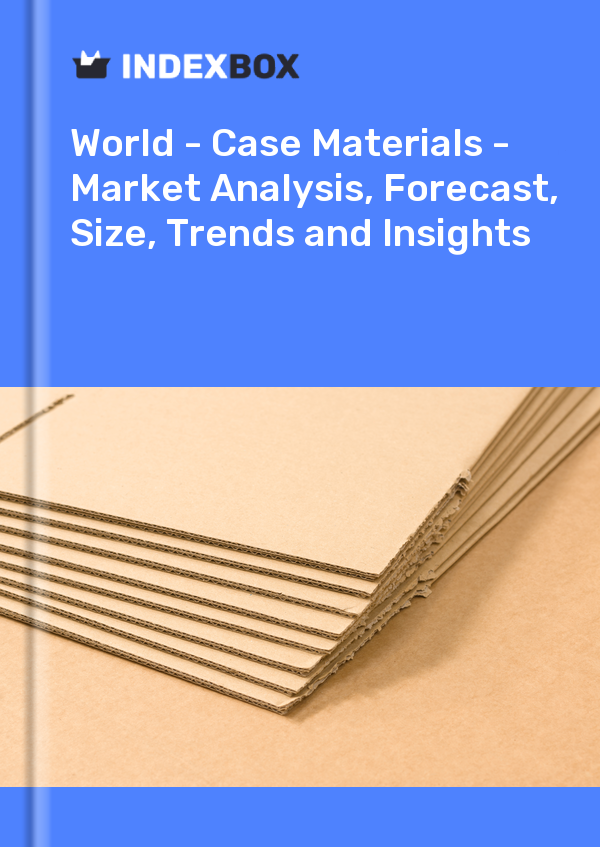
IndexBox has just published a new report: 'World - Case Materials - Market Analysis, Forecast, Size, Trends and Insights'. Here is a summary of the report's key findings.
In 2019, the global paperboard case material market decreased by -8.4% to $116.1B for the first time since 2016, thus ending a two-year rising trend. The market value increased at an average annual rate of +1.6% from 2013 to 2019; the trend pattern remained consistent, with only minor fluctuations being recorded throughout the analyzed period. Global consumption peaked at $126.7B in 2018, and then fell in the following year.
Consumption by Country
The countries with the highest volumes of paperboard case material consumption in 2019 were China (45M tonnes), the U.S. (29M tonnes) and Japan (9.4M tonnes), with a combined 50% share of global consumption. These countries were followed by India, Germany, South Korea, Mexico, Brazil, Russia, Italy, France and Spain, which together accounted for a further 26%.
From 2013 to 2019, the most notable rate of growth in terms of paperboard case material consumption, amongst the main consuming countries, was attained by India, while paperboard case material consumption for the other global leaders experienced more modest paces of growth.
In value terms, China ($48.6B) led the market, alone. The second position in the ranking was occupied by the U.S. ($14.2B). It was followed by Japan.
The countries with the highest levels of paperboard case material per capita consumption in 2019 were South Korea (99 kg per person), the U.S. (89 kg per person) and Germany (83 kg per person).
Production
In 2019, approx. 168M tonnes of paperboard case materials were produced worldwide; growing by 2.9% compared with 2018 figures. The total output volume increased at an average annual rate of +2.4% from 2013 to 2019; the trend pattern remained consistent, with somewhat noticeable fluctuations being recorded throughout the analyzed period.
Production By Country
The countries with the highest volumes of paperboard case material production in 2019 were China (44M tonnes), the U.S. (35M tonnes) and Japan (9.8M tonnes), with a combined 53% share of global production. Germany, India, South Korea, Brazil, Russia, France, Mexico, Indonesia and Thailand lagged somewhat behind, together comprising a further 27%.
From 2013 to 2019, the biggest increases were in India, while paperboard case material production for the other global leaders experienced more modest paces of growth.
Imports
In 2019, supplies from abroad of paperboard case materials decreased by -1% to 29M tonnes for the first time since 2012, thus ending a six-year rising trend. The total import volume increased at an average annual rate of +2.9% from 2013 to 2019; the trend pattern remained relatively stable, with somewhat noticeable fluctuations being observed in certain years. The growth pace was the most rapid in 2018 with an increase of 5.1% y-o-y. As a result, imports attained a peak of 29M tonnes, and then declined in the following year. In value terms, paperboard case material imports contracted to $16.9B (IndexBox estimates) in 2019.
Imports by Country
In 2019, Germany (2.4M tonnes), Italy (2M tonnes), Poland (1.8M tonnes), Mexico (1.3M tonnes), the U.S. (1.3M tonnes), France (1.2M tonnes), China (1.2M tonnes), the UK (1.1M tonnes), Belgium (1M tonnes), Spain (1M tonnes), the Netherlands (0.8M tonnes) and Canada (0.7M tonnes) was the main importer of paperboard case materials in the world, constituting 55% of total import.
From 2013 to 2019, the biggest increases were in China, while purchases for the other global leaders experienced more modest paces of growth.
In value terms, the largest paperboard case material importing markets worldwide were Germany ($1.3B), Italy ($1.1B) and the U.S. ($993M), together accounting for 20% of global imports. These countries were followed by Poland, Mexico, China, France, the UK, Spain, Canada, Belgium and the Netherlands, which together accounted for a further 35%.
Import Prices by Country
In 2019, the average paperboard case material import price amounted to $579 per tonne, which is down by -11.3% against the previous year. Over the period under review, the import price saw a slight contraction. The growth pace was the most rapid in 2018 an increase of 14% year-to-year. As a result, import price attained the peak level of $653 per tonne, and then reduced in the following year.
There were significant differences in the average prices amongst the major importing countries. In 2019, the country with the highest price was the U.S. ($749 per tonne), while Belgium ($491 per tonne) was amongst the lowest.
From 2013 to 2019, the most notable rate of growth in terms of prices was attained by China, while the other global leaders experienced more modest paces of growth.
Source: IndexBox AI Platform




